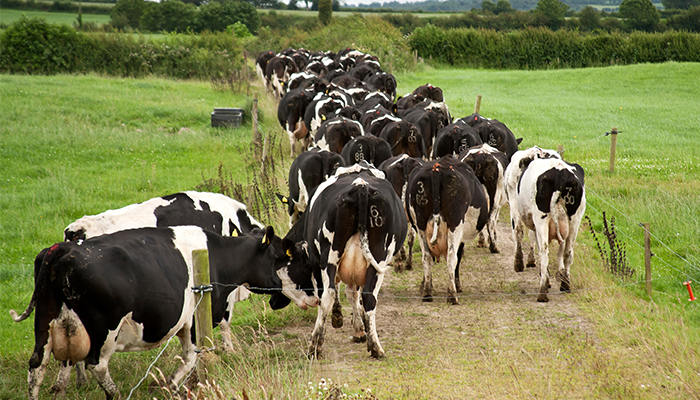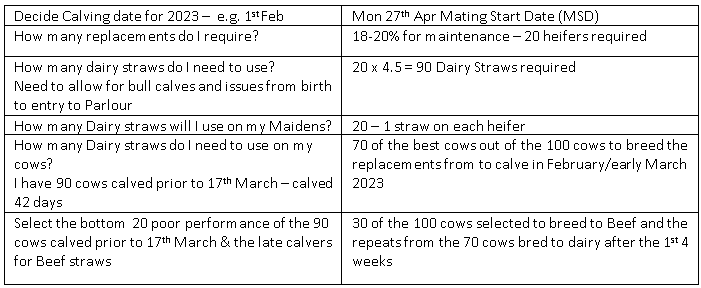23 May 2022
Getting cows back in calf

Pauline O’Driscoll, Teagasc Dairy Advisor, Skibbereen, discusses the importance of nutrition for breeding, EBI and getting cows back in calf. While discussing the breeding season she has tips on targets, plans and goals and she lists bull selection targets to keep in mind
Nutrition, EBI and Getting cows back in calf
The herd’s performance and the fertility performance is as a result of a number of factors. To try to maximise these you will need:
- To adequately feed your cows (energy, protein, minerals and vitamins)
- To ensure the Health status of your herd is good (If experiencing less than optimum fertility or milk solids production, discuss with Vet/Advisor/ consider joining a Herd Health screening programme)
- To breed for a fertile Cow, to plan for & manage the breeding season
As cows approach the Breeding season they need to be on a rising plane of nutrition & NOT losing weight.
FEED REQUIREMENTS
Grazed Grass is the most economical way to feed the cow, we must try maximise the grass intakes daily. Care is needed not to over–estimate grass intakes as overestimating grass intake by 1kg DM is the same as reducing concentrate feeding by 1kg.
If / when there is plenty of good quality grass available, the protein level in milk should at this point be increasing. However, the protein level in your herd is relative to your herd and the genetic potential in the herd, (your cows EBI). If milk protein results are good and your grass graze outs are good (down to 4cm), if cows are going into grass covers of 1400/1500kgdm, then hold concentrate levels. If proteins are good BUT if graze out is poor then you need to reduce the concentrate level being fed if currently being fed at high levels. By doing this you will increase the grass being consumed by cows and also achieve better clean outs whilst ensuring the cow is fully fed. At this stage you may also need to be considering removing excess grass as bales, reseeding some poor performing paddocks or closing up some more ground for silage.
Feed an appropriate level of concentrate based on how much your cows are consuming and the yield. To support the energy requirements of a cow producing 2kg Ms on 16kg grass dry matter, there is a requirement of about 2kg concentrates.
Grass alone at this time does not meet the Cow’s Phosphorus, Calcium, Selenium, iodine and zinc requirements. Cows also need a daily intake of Cal mag to prevent grass Tetany. Dietary deficiencies of these minerals are linked to poor fertility, cystic ovaries, anoestrus, irregular or supressed heats and early embryonic death.
Depending on the performance of the cow, even though her energy demands may not require concentrates, feeding 1 / 1.5 kg of concentrates may be one of the cheapest and importantly the most effective way of supplying minerals in advance of and during the breeding season.
Breeding Season
In 2021 the National average 6 week calving rate was 67%. So on average if we use an example of 100 animals calving down – then 67 animals calved in the first 6 weeks nationally, this includes both Cows and heifers. The number of April and May and June calvers was 12 %, 7% and 2% respectively. Achieving a high level of reproductive efficiency in the Dairy herd underpins profitable grass-based milk production.
The reproductive cycle of the cow requires a period of rest & recovery before she can go back in calf again. Identify later calving cows and any cows with issues – this group includes Cows calved within four weeks of the start of breeding season, they warrant special attention to help ensure that they go back in calf. Also Cows with BCS of less than 2.75 at MSD or in 3 weeks prior, Cows that had difficult calving’s, milk fever, lameness, E.coli mastitis. By identifying these animals it enables you to pay closer attention to pre breeding heats, to take early intervention & to intervene early in the breeding season by your vet if necessary.
Once a day – this approach is typically used on low SCC, late calving cows or thin / low BCS cows. It works on the principle that once a day milking reverses the trend towards body condition loss in early lactation. Milking them once a day from calving speeds up the resumption of their reproductive cycle. They will also have a higher conception rate to first service. Using the once a day approach, cows typically receive AI within 50 days of calving.
The Hormonal Intervention approach – there are a variety of hormonal treatments to induce heat in cows that have been calved greater than 30 days or more , BUT that are not cycling – careful adherence to the times and the administering of the programme critical and Veterinary assistance and advice is required.
Targets, Plans & Goals
- Decide your planned start calving date – your start AI date will be dictated by this
- Maintaining 82% of the current 2022 milking herd for the 2023 season & to achieve a high 6 week in calf rate.
- Have the maiden Heifers calving in February
- Breed for an adequate number of replacements from the highest genetic merit cows ( using EBI reports/Milk recording to select the animal you wish to breed replacements off)
- Decide which method OR combination of heat detection that you are going to use. Tail paint is an excellent, convenient and cost effective way of detecting cows in heat early in the season. Ideally for heifers use two methods as they can be difficult to detect accurately. Scratch cards, paint sticks/Crayons, vasectomised bulls are superior to tail paint with heifers, as heifers are not heavy enough in many cases to rub off the tail paint, unlike cows.
- Decide on how many AI straws do I use?
PLANNING THE SEASON – EXAMPLE 100 COWS AND 20 MAIDEN HEIFERS

- Know your herd’s strengths and weaknesses. Refer to your ICBF Herd EBI scorecard to help establish what these are.
- Select a team of high EBI AI bulls that will improve your herd when breeding for your Dairy replacements. For a 100 cow herd a minimum of 8 bulls should be used with equal usage of each bull across the herd. The ICFB dairy active bull list is a list of Bulls that are available across suppliers that have an EBI reliability of more than 35%, that have calving reliability data of greater than 70% and where there are at least 50 calving records for the bulls.
- Target High-EBI females, typically maiden heifers, first and second calvers for the next generation of Replacements. Easy calving is crucial, especially so for the Maiden heifers should be inseminated with easy calving sire with high reliabilities for calving. Lower EBI cows, poorer performers should be bred to beef AI from the start of the breeding season.
- Use the Dairy Beef Index (DBI) to select suitable beef AI sires for your Dairy herd. A team of bulls should be selected that suit the various cow sin your herd. Bulls with higher beef merit figures should be selected for older, bigger mature cows.
- Use the ICBF Herd plus Sire Advice tool to help manage your breeding programme. It will allocate your bulls selected to cows based on their strengths and weaknesses and will manage inbreeding also. For more information on this tool, speak to ICBF Herd Plus, your Teagasc advisor / AI Company.
Table: EBI – Dairy Bull Selection Recommendations

The Teagasc Dairy Specialists issue an article on a topic of interest to dairy farmers every Monday here on Teagasc Daily. Find more on Teagasc Dairy here | Along with Teagasc specialists and researchers, Teagasc advisors also regularly provide articles of interest on Teagasc Daily. Contact your Teagasc advisor at your local Teagasc office
